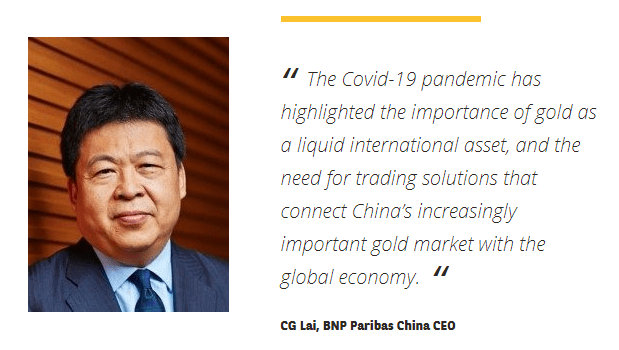The surge in global demand for gold since the onset of Covid-19 has underlined the importance of trading links with China, the world’s biggest producer.
China’s homegrown gold exchange has become one of the world’s biggest precious metals markets, offering access to spot and derivatives contracts to both local and global investors.
Few materials spark the imagination in the same way as gold. Its beauty, scarcity and longevity make it prized both as jewellery and as a store of value that can be passed down over generations. For investors, it is a safe haven in times of uncertainty: an asset that can outlast financial crises and a hedge against inflation when fiat currencies lose their value.
Gold’s allure was on full display at the onset of the Covid-19 pandemic in 2020. Funds Europe reported that investors turned to gold as protection against uncertainty, adding an unprecedented 877 tonnes to gold ETFs globally – worth a total of $48 billion. As well as providing a safe haven, gold benefited as interest rate cuts eroded the appeal of holding cash or bonds, while government stimulus programmes supplied liquidity for investment in the precious metal.

Local allure
For China, gold is a key strategic element in its economic liberalisation and development plans – and the Shanghai Gold Exchange (SGE) is the means to make it happen. Founded in 2002, SGE is the only official platform for trading gold in the country, and has become the world’s biggest purely physical spot exchange and third-largest venue by total trading volume: in 2020 it facilitated the exchange of 58,671.55 tonnes of gold, amounting to trading volumes of RMB43.32 trillion ($6.71 trillion). As the source of the world’s only RMB-denominated gold price, it has become the most significant gold price-discovery venue in Asian trading hours.
This rapid growth also signals China’s own ascendancy in gold production: it has been the world’s largest gold producer since 2007, and produced about 15% of all the gold mined in the world in the past decade. Last year China produced 368 tonnes – 12% more than Australia, the world’s second-largest producer. Production on this scale requires a market-making mechanism for bullion that is connected to the world’s markets – at a price that reflects local supply and demand.
In its almost 20 years of operation, SGE has pursued a path of ongoing development and internationalisation. Its ‘International Board’, unveiled in 2014 as part of the Shanghai Free-Trade Zone, has grown in importance as a portal for international traders to access the onshore Chinesemarket. The launch of Hong Kong Gold Connect in October 2017 gave cross-border bullion flows a further boost, as did the Gold Road Project in 2019, which supports the Belt & Road scheme by connecting with participating local markets. In 2020, SGE was accredited by the People’s Bank of China as a central counterparty, enabling it to net participants’ transactions and mitigate counterparty risk – a key development for attracting international investors.
Global gold
In October 2019, SGE and COMEX, owned by CME Group, agreed a cross-licensing deal that introduced the Chinese benchmark to the world’s largest gold futures market. The move made Shanghai gold futures available via COMEX, in both renminbi and US dollars, and gave Chinese investors access to SGE-listed NYAuTN gold futures based on the COMEX Asia spot price.
Together, these products enable global traders on both markets to go short or long the contracts to take a view on the price of gold, the Chinese currency or on local demand, which has historically seen Shanghai prices reflect a premium. By the end of 2020, the two contracts had recorded 243.6 tonnes and 241.18 tonnes respectively in trading volume.
As China continues to open its financial sector and more international investors enter the onshore market, BNP Paribas’ SGE membership will enable it to respond to rising demand for complex derivatives and cross-border trading products.
“The Covid-19 pandemic has highlighted the importance of gold as a liquid international asset, and the need for trading solutions that connect China’s increasingly important gold market with the global economy,” said CG Lai, BNP Paribas China CEO. “BNP Paribas has committed to these markets as a component of its commodities offering, for both China-based businesses and global entities wanting access to China’s flourishing gold market.”
Connecting china’s gold market to the world
BNP Paribas received approval to trade gold on an over-the-counter (OTC) basis through SGE in 2017; Main Board membership followed in 2019, enabling the Bank to trade in listed gold contracts and other gold derivatives.
“SGE is one of the most important trading venues in the global precious metal markets,” said CG Lai, BNP Paribas China CEO. “Membership of the exchange expands BNP Paribas’s global commodity derivatives platform, enabling us to provide our Chinese clients with the full spectrum of gold-related products and services.”
Already a forward market-maker for the London Bullion Market Association (LBMA), BNP Paribas is also a Bank of England-designated gold storage bank, and it provides access to US trading through clearing membership of the COMEX metals exchange.

